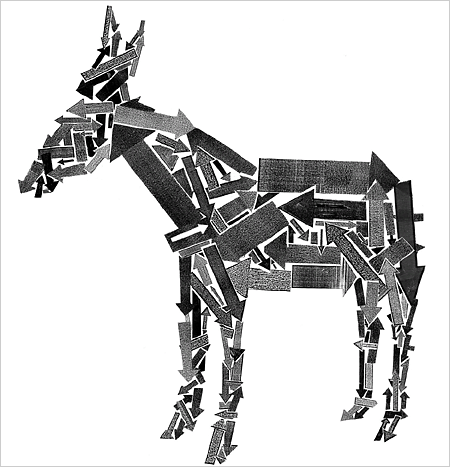New Haven
RECENTLY, an internal disagreement in the Democratic Party made headlines. That probably sounds familiar, since disagreements over party strategy are nothing new in the Democratic Party.
But the recent conflict between Representative Rahm Emanuel of Illinois, chairman of the Democratic campaign committee in the House, and Howard Dean, chairman of the Democratic National Committee, is more than just another family squabble -- it shows just how difficult changing the course of party history can be.
Mr. Emanuel and others have questioned Mr. Dean's program to build the party organization in red states as well as blue ones. They want the committee to spend its money on key Congressional races this fall because they believe that the party has a chance to win control of the House in 2006 if it pours its resources into the most competitive races.
Mr. Dean has a different approach. He believes that for the Democrats to regain the majority and make it stick, they will have to build a strong organizational foundation everywhere, even in those places where Democrats don't have an immediate chance. Democrats may not win many red-state races this year, but Mr. Dean believes that they will be better off in the long run if they start shoring up the party in Republican strongholds now.
What is missing from the current debate is a clearer appreciation for how the Democrats got to where they are today, and how the current leaders might learn from the record of the past.
Since the New Deal, Democrats have given party building short shrift. Democratic presidents tended to use the formal party apparatus as an instrument for raising money but looked to other vehicles for building political support. They relied on organized labor to get out the vote; on urban machines and congressmen in the South to control local party operations; and on the strength of incumbents to win their own re-elections.
While this was a winning formula, it could not last forever. By failing to create durable organizational capacities in their party, Democrats were often forced to cobble together new political networks with each campaign season. Republican presidents and party chairmen, on the other hand, were driven by their perpetual Congressional minority status to strengthen their organization as a means of expanding their party. While Republicans won many presidential elections, they were the perennial losers in Congressional and state-level elections and did not gain parity with the Democrats among self-identified partisan voters until 2004.
To establish a new majority, Republicans aggressively built up their organizational presence in weak Republican areas, especially in the South. As early as the 1950's, they ran schools to train activists and campaign managers. By the 1970's, they were developing new methods of recruiting candidates and enrolling party workers and volunteers; they created teams of "field men" to travel from campaign to campaign to lend their expertise where needed; they built new small-donor fund-raising networks and became adept at sending money where it needed to go; and they invested in technology and voter database management. What's more, these practices were disseminated down to the local level.
For example, Republican presidents focused on party building in the historically Democratic states of South Carolina and Virginia in the 1970's. They gave local leaders the resources they needed to develop a campaign-support system that would entice attractive candidates to run for office as Republicans. Political neophytes, like business and religious leaders, were promised support -- if only they would take a chance on running.
New candidates and activists were sent to work for the national committee, the White House, the Congressional campaign committees and affiliated political action groups. Many of the most prominent Republican leaders of the recent past -- Karl Rove, Ed Gillespie -- got their start participating in party-building programs.
Using detailed voter lists, phone banks and grass-roots workers, Republicans began to collect wins -- at the mayoral, state legislative and, eventually, the gubernatorial and Congressional levels. Each victory softened the electorate's view of the Republican Party; more Republican officeholders encouraged more Republican voters; more Republican voters encouraged more and better Republican candidates to run for office.
And because every Republican president since Eisenhower contributed enthusiastically to these party-building efforts, the party was able to benefit from White House largess, presidential fund-raising prowess and the power of presidential persuasion.
Republicans did not emerge from the minority by trying to win a bare majority in the House or Senate. They put their organization to work for them and discovered that party building bred more party building.
This seems to be precisely what Howard Dean is trying to do. By developing an organizational structure now, Mr. Dean hopes that the Democrats will have something sturdy to rely on if, and when, they win back the White House.
It's uncertain whether Mr. Dean will succeed. After all, Mr. Emanuel makes a persuasive argument for his approach. Why should the Democrats trade a chance to win the House now for an uncertain future?
The answer? Because a victory now will most likely be short-term. As the Republicans have shown, creating a durable electoral majority requires a firm organizational foundation, something the Democrats don't have. But if Mr. Dean can hold fast to his plan, they just might be on the way to getting one.











